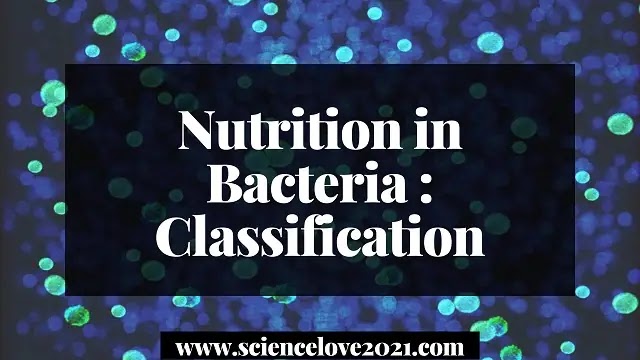Nutrition in Bacteria: Classification
Bacterial Nutrition is classified into two categories -
(A) Autotrophic bacteria or "self feeders"
(B) Heterotrophic bacteria or "other feeders"
(A) Autotrophic bacteria
Autotrophic bacteria are capable of synthesizing their food from organic or inorganic substances are called autotrophic. The autotrophic further divided into two subgroups based on their source of energy -
(1) Photoautotrophic bacteria
(2) Chemoautotrophic bacteria
(1) Photoautotrophic bacteria
(2) Chemoautotrophic bacteria
(1) Photosynthetic bacteria - Also known as photoautotrophic or photolithotrophic bacteria. Like higher plants, they are capable of converting radiant energy into chemical energy. They use light as a source of energy to produce their own food. Photosynthetic bacteria possess bacteriochlorophyll. In the presence of sunlight, they can produce carbohydrates. using CO2 as the source of carbon, electron donors are H2S, elemental S, and other sulfur-containing inorganic compounds. Bacterial photosynthesis is an anaerobic process not involving the photolysis of water with the evolution of oxygen (O2). This process is called anoxygenic (without producing oxygen) photosynthesis.
Photosynthetic bacteria may be classified into the following two main types -
(a) Green sulfur bacteria- These are small non-motile, rod-shaped bacteria which are strictly anaerobic photoautotrophs. Their photosynthetic pigment is chlorobium chlorophyll located in the invaginations of cytoplasmic membrane. These bacteria use H2S or other reduced inorganic sulfur compounds as electron donors. Elemental sulfur formed by the product in this process is deposited extracellularly. Chlorobium, Prosthecochloris, Pelodictyon, and Clathrochloris are four well-known examples of green sulfur bacteria.
6CO2 + 12H₂S →C6H12O6+ 6H2O + 12S
(b) Purple Sulphur bacteria- These are also autotrophs and their photosynthetic pigments are bacteriochlorophyll a and b. In this case, in place of HS and elemental sulfur, the electron donors are some other sulphur containing organic or inorganic compounds but the sulphur is not the byproduct, though the light is utilized, example Chromatium.
6CO₂ + 15H2O + 3Na2S2O3 → in presence of light and Bacteriochlorophyll → C6H12O6 + 6H₂O + 6NaHSO4
(c) Non-Sulphur Bacteria- These are motile bacteria found in mud and stagnant water. These also have bacteriochlorophyll as photosynthetic pigment. In their metabolism organic compounds are utilized as hydrogen donor which replaces sulphur. Thus sulphur is never accumulated within the cell. The extent of reduction depends upon the organic substrate. For example -
2C3H6O2(Propionic acid) + H2O + CO₂ → 7(CH2O) Carbohydrate
C4H6O2 (Malic acid) → 3(CH2O) + CO₂ (Carbohydrate)
(2) Chemosynthetic bacteria- These bacteria are without photosynthetic pigments. For the synthesis of their own organic food, (carbohydrates), they obtain carbon from CO2 of the atmosphere and necessary energy from the oxidation of inorganic or organic compounds. such as hydrogen sulphide (H2S), ferrous compounds (Fe²+), molecular (H2), ammonia (NH3) and nitrites (NO2-).
They are the following types-
(a) Sulphur bacteria - These bacteria occur in sulfur-containing terrestrial and aquatic environments. They derive energy from the oxidation of reduced sulfur compounds. The sulfur bacterium Beggiatoa oxidizes hydrogen sulfide to elemental Sulphur.
H2S + 1/2 O2 → S + H2O
S + H2O + 1/2 O2 → H2SO4 + Energy
H2 + 1/2 O2 → 2H2O + energy
2Fe(HCO3)2 + 1/2 O2 + H2O → 2Fe(OH)3 + 4CO2 + energy
Ferrous bicarbonate
(d) Nitrifying bacteria - The nitrifying bacteria are found in the soil. Through metabolic activities, they convert ammonia (NH3) or ammonium ion (NH4+), which is formed by the breakdown of animal and plant proteins. During decay to nitrates (NO3-). The formation of NO3- from NH3 or NH4+ is called nitrification. This process in two steps:
(i) First step Nitrosomonas is the most common organism found in soil that oxidizes ammonia into nitrite ion. (-NO₂-).
2NH3 + 3O2 → 2NO2- + 2H+ + 2H2O + E
(i) Second step Nitrobacter oxidizes nitrite to nitrates ion (-NO3-).
2NO2- + O2 → 2NO₂- + Energy
Nitration Nitration
(B) Heterotrophic bacteria
Heterotrophic bacteria obtain readymade food from any organic source. They can be distinguished into three major nutritional categories.
1. Parasitic bacteria - Parasitic bacteria that feed on living organisms are called as parasitic bacteria. The organism from which parasitic bacteria obtain their food is known as host. Some parasitic bacteria are known to cause diseases in plants (example- citrus canker) and animals (for example- pneumonia, typhoid), and such bacteria are called pathogenic bacteria. Example- Xanthomonas citri, Salmonella typhii, etc.
1. Parasitic bacteria - Parasitic bacteria that feed on living organisms are called as parasitic bacteria. The organism from which parasitic bacteria obtain their food is known as host. Some parasitic bacteria are known to cause diseases in plants (example- citrus canker) and animals (for example- pneumonia, typhoid), and such bacteria are called pathogenic bacteria. Example- Xanthomonas citri, Salmonella typhii, etc.
2. Saprophytic bacteria - Saprophytic bacteria grow on dead and decaying organic matter. They obtain their food by decomposing complex organic molecules into simple inorganic constituents. The decomposition of carbohydrates and proteins by saprophytic bacteria is technically known as fermentation and putrefaction;
- Fermentation - The breakdown of sugars by yeast is a common example of fermentation. In this process, CO2 is released. Similarly, lactic acid fermentation of milk is carried out by lactic acid bacteria (Lactobacillus).
- Putrifaction - In putrifaction reduction of protein to peptone, polypeptide, peptides, and amino acids takes place by enzymes secreted by anaerobic bacteria. This process does not require oxygen, but many saprophytic bacteria which breakdown amino acids into methane, CO2, NH3, H2 and N2 do require oxygen.
The bacteria inhabiting the intestines of man and animals are good examples of symbiotic bacteria. The enzymes secreted by these bacteria are helpful in the digestion of cellulose and in return, they obtain their food from the host. Similarly, root nodule bacteria (Rhizobium), present in the roots of leguminous plants, fix atmospheric nitrogen to augment their nitrogen supply and in return, the plants provide them shelter and carbohydrates.




No comments:
Post a Comment